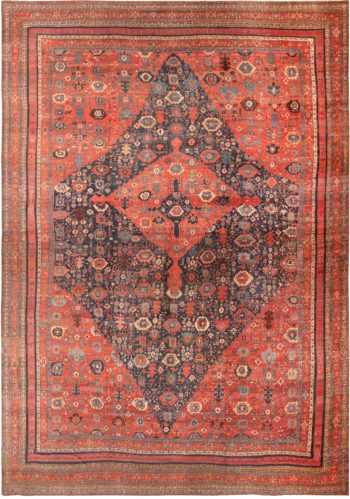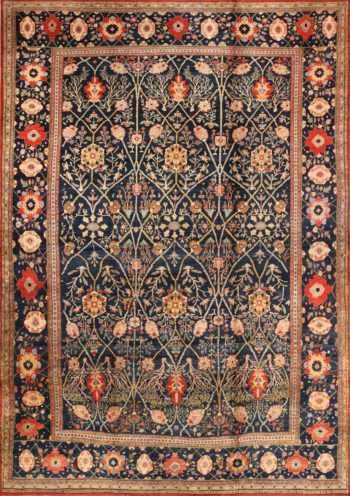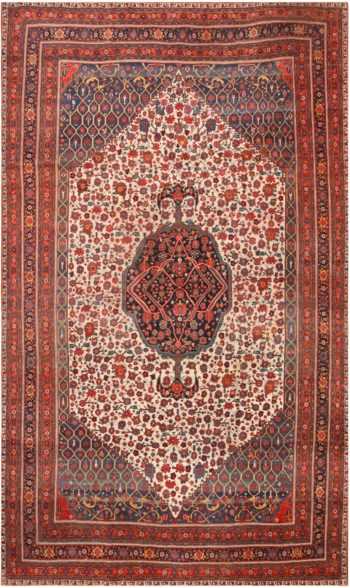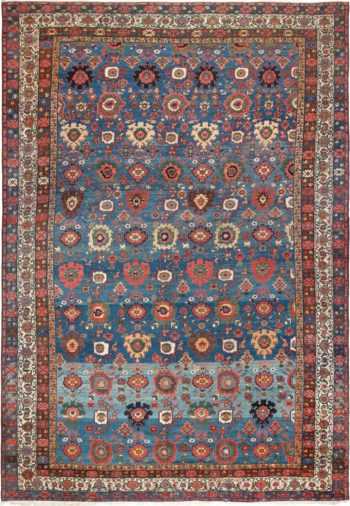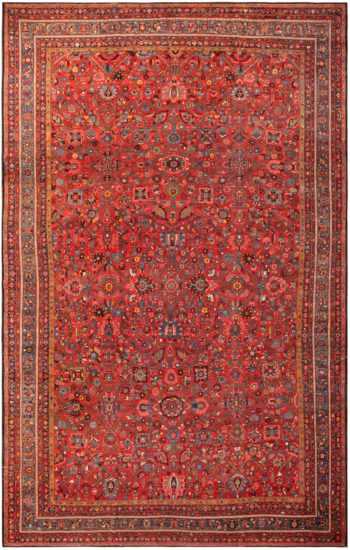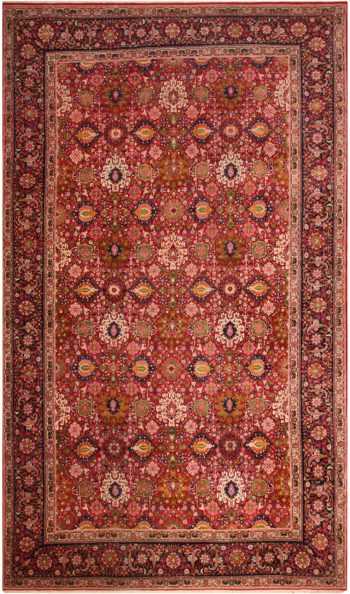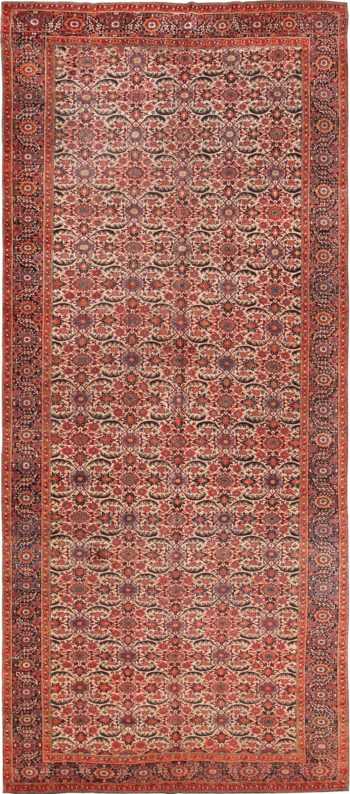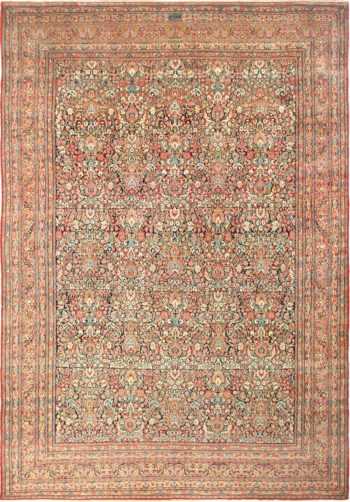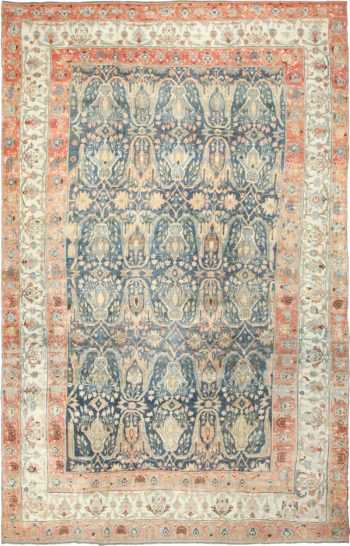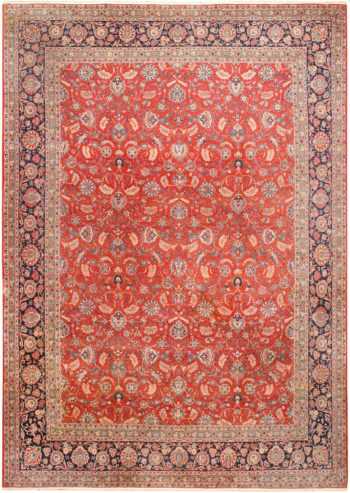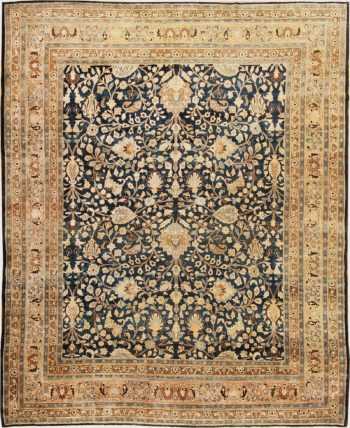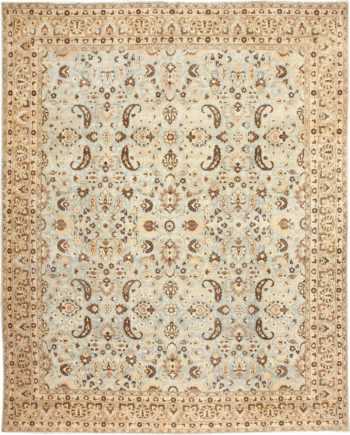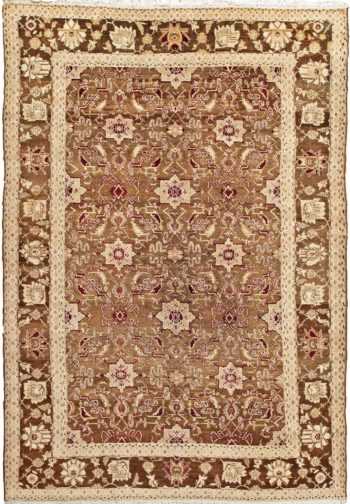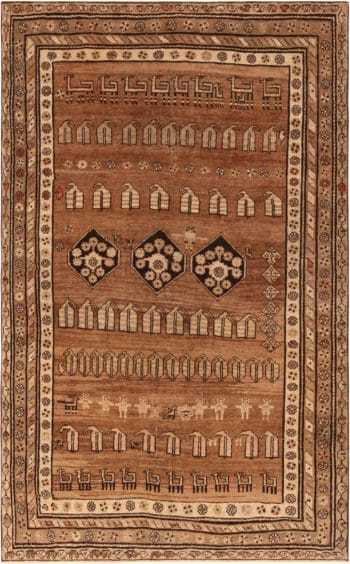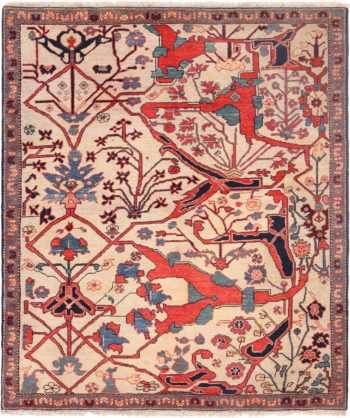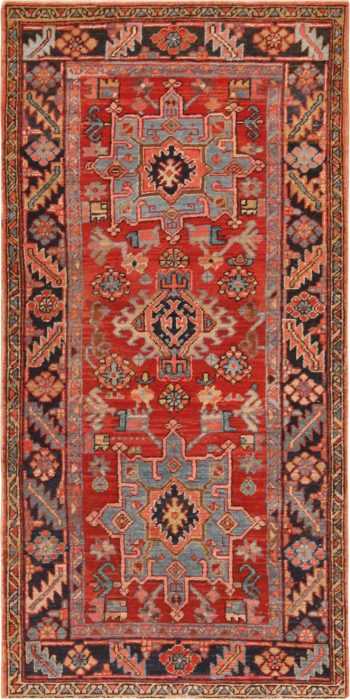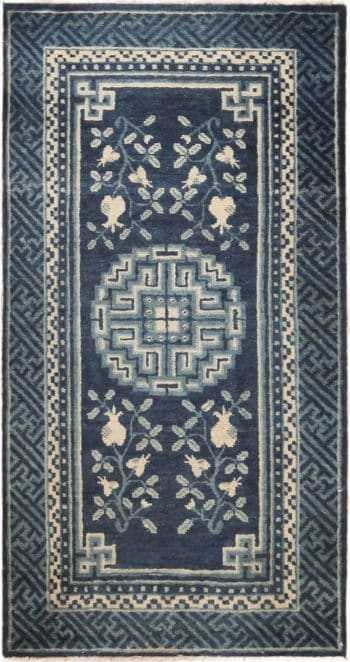Durable Rugs
Here are just some examples of extremally durable area rugs
-
Durable Rustic Palace Size Antique Tribal Persian Bidjar Rug 71773
$145,000.00Size: 19 ft 5 in x 31 ft 3 in (5.92 m x 9.52 m) -
Oversized Navy Blue Antique Indian Agra Rug 71249
$145,000.00Size: 16 ft 10 in x 25 ft 6 in (5.13 m x 7.77 m) -
Beautiful Rustic Tribal Oversized Antique Durable Casual Elegant Persian Bidjar Rug 72040
$36,000.00Size: 13 ft 2 in x 21 ft 4 in (4.01 m x 6.5 m) -
Oversized Blue Jewel Tone Antique Tribal Persian Malayer Geometric Abrash Area Rug 45761
$165,000.00Size: 14 ft 6 in x 20 ft 6 in (4.42 m x 6.25 m) -
Oversized Antique Persian Bidjar Rug 71639
$46,500.00Size: 12 ft 10 in x 20 ft 3 in (3.91 m x 6.17 m) -
Large Antique Happy Jewel Tone Persian Kerman Rug 71576
$58,000.00Size: 11 ft 10 in x 20 ft (3.61 m x 6.1 m) -
Gallery Size Antique Persian Bidjar Herati Rug 70552
$28,500.00Size: 8 ft 7 in x 19 ft 6 in (2.62 m x 5.94 m) -
Large Blue Background Classic Traditional Floral Design Antique Persian Khorassan Rug 49517
$32,000.00Size: 13 ft 3 in x 19 ft 2 in (4.04 m x 5.84 m) -
Large Light Blue Antique Persian Garous Design Bidjar Rug 50217
$62,000.00Size: 11 ft 10 in x 18 ft 7 in (3.61 m x 5.66 m) -
Large Antique Persian Garous Bidjar Blue Background Rug 71343
$76,500.00Size: 11 ft x 17 ft 8 in (3.35 m x 5.38 m) -
Large Antique Persian Kashan Dabir Rug 70970
$19,500.00Size: 12 ft x 17 ft (3.66 m x 5.18 m) -
Large Floral Antique Persian Sarouk Rug 70814
$12,500.00Size: 10 ft x 17 ft (3.05 m x 5.18 m) -
Antique Khorasan Persian Rug 42809
$38,000.00Size: 12 ft 2 in x 15 ft 9 in (3.71 m x 4.8 m) -
Beautiful Fine Durable Light Blue Large Antique Persian Khorassan Rug 48776
$28,000.00Size: 11 ft 9 in x 15 ft (3.58 m x 4.57 m) -
Durable Floral Vintage Navy Blue Persian Bidjar Rug 46734
$18,000.00Size: 10 ft x 13 ft 9 in (3.05 m x 4.19 m) -
Beautiful Tribal and Durable Antique Persian Shrub Design Bidjar Gallery Carpet 50267
$18,000.00Size: 4 ft 1 in x 12 ft 6 in (1.24 m x 3.81 m) -
Beautiful Rich Red Color Vintage Indian Agra Rug 48756
Size: 7 ft 9 in x 10 ft (2.36 m x 3.05 m) -
Antique 8 Pointed Star Design Green Indian Agra Rug 44605
Size: 5 ft 9 in x 8 ft 5 in (1.75 m x 2.57 m) -
Vintage Tribal Brown Earth Tone Persian Paisley Bidjar Rug 72152
$4,400.00Size: 4 ft 2 in x 6 ft 5 in (1.27 m x 1.96 m) -
Vintage Turkish Bidjar Design Wagireh Sampler Rug 71105
$3,800.00Size: 5 ft 4 in x 6 ft 3 in (1.63 m x 1.9 m) -
Small Durable Casual Rustic Antique Tribal Persian Heriz Rug 71977
$5,600.00Size: 3 ft 1 in x 6 ft 2 in (0.94 m x 1.88 m) -
Small Rustic Tribal Antique Geometric Persian Medallion Heriz Rug 72037
$5,600.00Size: 4 ft 7 in x 5 ft 10 in (1.4 m x 1.78 m) -
Beautiful Fine Small Size Antique Persian Tabriz Herati Rug 72041
$3,500.00Size: 4 ft 2 in x 5 ft 9 in (1.27 m x 1.75 m) -
Small Blue Background Pomegranate Design Antique Chinese Rug 72062
$650.00Size: 2 ft 3 in x 4 ft 3 in (0.69 m x 1.3 m)
Buying Durable Rugs For High Foot Traffic Areas
Exploring the durability of area rugs
Durable Rugs – The issue of rug durability — that is, how long it will last and how resistant it will be to wear and tear — is an important factor for you to consider when you’re buying area rugs.
It should certainly be noted that not all area rugs are produced with the same capacity to stand up to prolonged use and regular foot traffic. It is certainly true that some carpets and rugs hold up better over time than others. The relative durability of a rug will depend on several factors such as – the quality of the wool, the tightness of the weave, and the overall condition of the piece at the time of purchase (to name just a few).

Durable Rugs
One of the most important factors in determining the durability of rugs is the wool with which it was woven. For example, a rug made from lanolin rich, moist, lustrous, healthy wool will withstand the friction of traffic better than a rug made from dry, brittle, dull wool.
However, you should also note that firm rugs that are tightly woven, with a high vertical compression or density of knots, will also stand up better to foot traffic than a floppy, more loosely woven rug. This would be irrespective of the overall quality of the wool that rug was woven with.
Antique rugs that are densely woven from fine wool can still withstand quite a bit of foot traffic as long as they have a fair degree of pile intact. But an antique piece with very low worn pile is best used in an area with a lower volume of daily foot traffic.
If rug durability is an issue, it is important to ascertain the wool quality, density, and depth of the pile, whatever the age of the rug. It is also important to note that not all modern rugs that were created recently are automatically considered durable.
Carefully consider just where it is that your newly acquired antique, modern or vintage rug is going to be placed. Try to determine the average amount of foot traffic that that particular area sees and use that information to help you decide whether you are looking for an especially durable rug, or perhaps a piece a little less resistant to wear but that you like a bit more.
The best way to know if rugs are durable or not, would be to ask the rug dealer before you buy the rug. Make sure they tell you if there are any “problems”, repairs or other condition issues that you should take into consideration before you move forward with your purchase. If at any point you feel like you are not getting the information you need, asking for a second opinion might be best.
What makes a rug durable?
A durable rug is one that can withstand heavy use, foot traffic, and everyday wear and tear while maintaining its original appearance and functionality.
Several factors contribute to the durability of an area rug:
- Material: The material of the rug is a significant determinant of its durability. Common rug materials include wool, nylon, polyester, polypropylene, and natural fibers like sisal and jute. Wool is known for its resilience and ability to bounce back after being compressed, making it highly durable. Synthetic materials like nylon and polyester are also durable and often more affordable than natural fibers.
- Construction: The way a rug is constructed plays a crucial role in its durability. High-quality rugs are often hand-knotted, hand-tufted, or machine-loomed. Hand-knotted rugs are the most durable, as the knots tightly hold the fibers in place. Hand-tufted and machine-loomed rugs are also durable, but they might have a lower density of knots compared to hand-knotted ones.
- Pile Height and Density: The pile height and density affect how well a rug can withstand wear. Rugs with shorter piles generally hold up better in high-traffic areas compared to long-pile rugs. Additionally, a denser pile with more fibers per square inch typically makes a rug more durable.
- Backing Material: The backing of a rug can influence its durability and stability. High-quality rugs often have sturdy and non-slip backings that keep the rug in place and prevent it from bunching up or sliding on the floor.
- Stain Resistance: Rugs treated with stain-resistant coatings or made from naturally stain-resistant materials are more likely to withstand spills and stains, making them easier to clean and maintain in the long run.
- Edges and Binding: Well-finished and properly bound edges help prevent fraying and unraveling, adding to the rug’s durability.
- Maintenance: Regular cleaning and proper maintenance contribute to the longevity of a rug. Vacuuming, spot cleaning, and professional cleaning when necessary help keep the rug in good condition and extend its lifespan.
- Indoor vs. Outdoor Use: If a rug is intended for outdoor use, it should be made from materials that can withstand exposure to the elements, such as sun, rain, and moisture. Outdoor rugs are designed to be more resistant to fading, mold, and mildew.
- Proper Usage: The way a rug is used can also impact its durability. Placing furniture on the rug can help distribute weight and reduce wear in high-traffic areas. Additionally, using rug pads under the rug can provide extra cushioning, prevent slipping, and protect both the rug and the floor.
By considering these factors, you can choose a rug that suits your specific needs and will remain durable and beautiful for years to come.
Which types of area rugs are the most durable?
The most durable rugs are typically those made from high-quality materials and constructed with solid craftsmanship.
Here are some types of rugs that are known for their exceptional durability:
- Wool Rugs: Wool is a natural fiber that is highly durable and resilient. It can withstand heavy foot traffic and compression without losing its shape. Wool rugs are also naturally stain-resistant and easy to clean.
- Hand-Knotted Rugs: Hand-knotted rugs are among the most durable due to their intricate construction. Each individual knot is tied by hand, creating a strong and long-lasting rug. These rugs can last for generations with proper care.
- Bamboo Silk Rugs: Bamboo silk rugs are made from renewable bamboo fibers and are known for their strength and durability. They are a good option for areas with moderate foot traffic.
When selecting a durable rug, it’s essential to consider factors such as the intended use, foot traffic in the area, and the level of maintenance you are willing to commit to. While all the rug types listed above are generally durable, the specific durability of a rug can also depend on its construction quality, pile density, and how well it is cared for over time.
Regular cleaning and proper maintenance are key to preserving the durability and appearance of any rug.
What rug material is durable and hard wearing?
The rug material that is known for being hard-wearing and durable is wool. Wool rugs are highly regarded for their ability to withstand heavy foot traffic and maintain their appearance over time.
Here are some reasons why wool is considered a hard-wearing rug material:
- Resilience: Wool fibers have a natural ability to bounce back after being compressed, which helps the rug retain its original shape and texture even in high-traffic areas.
- Strength: Wool is a strong and robust natural fiber, making it less susceptible to fraying or tearing compared to some other materials.
- Soil and Stain Resistance: Wool fibers have a natural waxy coating that helps repel dirt and liquids. This built-in stain resistance makes wool rugs easier to clean and maintain.
- Abrasion Resistance: Wool is resistant to abrasion, meaning it can withstand friction and wear caused by foot traffic without showing significant signs of damage.
- Color Retention: Wool is known for its excellent color retention properties. The fibers hold dyes well, preventing colors from fading or becoming dull over time.
- Insulating Properties: Wool is an excellent insulator, providing warmth and comfort underfoot while also helping to regulate indoor temperatures.
- Longevity: High-quality wool rugs, especially hand-knotted ones, have the potential to last for decades when properly cared for.
While wool is a standout choice for durability, it’s important to note that other rug materials can also be hard-wearing, depending on the specific rug’s construction and intended use. For instance, some synthetic materials like nylon and polypropylene may be engineered to be durable and resistant to wear.
When selecting a hard-wearing rug, consider the level of foot traffic in the area, the intended use, and your maintenance preferences. Wool is a versatile and reliable option that remains a popular choice for those seeking a durable and long-lasting rug.

